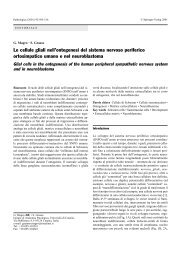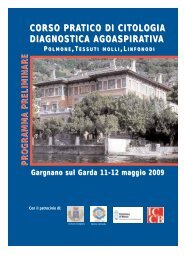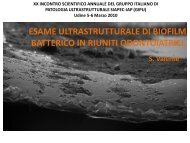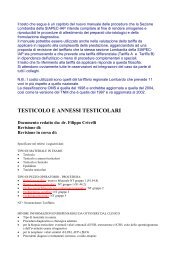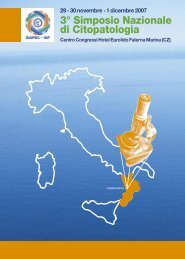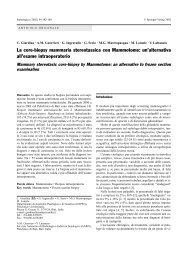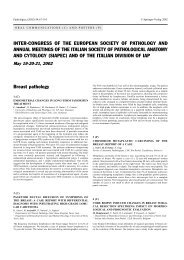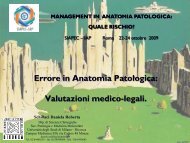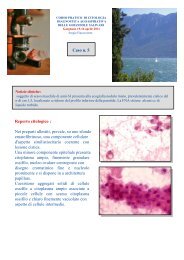You also want an ePaper? Increase the reach of your titles
YUMPU automatically turns print PDFs into web optimized ePapers that Google loves.
318COMUNICAZIONI LIBEREboth AMG and LGNiN. Such a data suggest to consider In-NiN as an autonomous category biologically located betweenAMG and LGNiN.Immunohistochemical evaluation of APC,β-catenin, E-cadherin and mismatch repairproteins in early onset gastric cancerC. Di Gregorio, L. Losi 1 , A. Scarselli, S. Beghelli 2 , C. Vindigni3 , A. Tomezzoli 4 , L. Saragoni 5 , A. Sidoni 6 , A. Scarpa 5Gruppo Italiano di Ricerca sul Cancro Gastrico (AnatomiaPatologica degli Ospedali di Carpi 1 , Verona 2 , Forlì 3 e delleUniversità di Modena 1 , Verona 2, Siena 3 , Perugia)IntroductionEarly onset gastric cancers (i.e. those diagnosed in patientsyounger than 40 years) are rare, and little is known abouttheir molecular pathogenesis. We studied the involvement ofboth the APC/β-catenin (Wnt) and microsatellite instabilitycarcinogenetic pathways by immunohistochemistry in gastriccancer of young patients.MethodsForty-eight early onset gastric cancer were studied for the immunohistochemicalexpression of APC, β-catenin, E-cadherinand of mismatch repair proteins (MLH1 and MSH2). Monoclonalantibodies were: APC (Abcam) at 1:500 , β-catenin(Transduction Labs,) 1:100, E-cadherin (Dako) 1:200, MLHland MSH2 (Pharmingen) at 1:100 diluition. Altered expressionof APC was considered when absence of cytoplasmic stainingwas seen in all the neoplastic cells. Altered expression of β-cateninwas considered when the tumor showed absence of membraneimmunoreactivity and/or nuclear/cytoplasmic immunoreactivity.Altered expression of E-cadherin was consideredwhen loss of membranous staining was noted. Lack of expressionof MLH1 and MSH2 proteins was defined as completeabsence of nuclear staining in tumor cells.ResultsAPC immunoreactivity was absent in 50% of cases; in the samecases ß-catenin expression was altered. E-cadherin immunoreactivitywas absent in 14 cases (29%) (in 7 cases associatedwith alteration of APC/β-catenin and in 3 cases withβ-catenin only).The altered expression of β-catenin alonewas observed in 6 cases (12%). The absence of MLH1 proteinwas seen in 5 cases (10%), all showing simultaneous alteredexpression of APC/β-catenin.ConclusionThe high frequency of altered expression of APC/β-cateninand E-cadherin, suggests the involvement of the Wntpathway in the majority of early onset gastric cancer. The microsatelliteinstability pathway plays a role in a minority ofcases.Determinazione immunoistochimicamediante “Hepatocyte” nei carcinomi gastricie del grosso intestinoD. Villari, M. Righi, E. Vitarelli, G. BarresiDipartimento di Patologia Umana, Università di MessinaIntroduzioneL’anticorpo monoclonale “Hepatocyte”, ritenuto specificoper epitopi delle cellule epatocitarie normali e neoplastiche,è stato recentemente proposto come marcatore immunoistochimicoper l’identificazione del carcinoma epatocellulare(HCC). Il nostro intento è stato quello di valutare la specificitàdi “Hepatocyte” studiando mediante determinazione immunoistochimicala presenza dell’epitopo che reagisce con“Hepatocyte” in carcinomi gastrici ed in adenocarcinomi colorettali.Materiali e metodi39 carcinomi gastrici e 18 adenocarcinomi colorettali. Doposmascheramento antigenico mediante pretrattamento in fornoa microonde si è effettuata una incubazione con l’anticorpomonoclonale primario “Hepatocyte” (clone OCH 1 E5,Dako, 1:80). Sono stati eseguiti controlli negativi e positivi.La percentuale di cellule positive è stata valutata secondo ilseguente score: 1 (0-5%), 2 (5-50%), 3 (>50%).RisultatiI risultati sono riassunti in Tabella I.ConclusioniL’anticorpo “Hepatocyte” mostra una elevata sensibilità perle neoplasie a differenziazione epatocitaria , tuttavia la positivitàin carcinomi gastrici e colorettali ne limita la sua utilizzazionecome marcatore specifico del HCC.Tab. I. Reattività di “Hepatocyte” in carcinomi gastrici ed in carcinomi colorettaliStaining score1 2 3Carcinomi gastrici 66,6 % (26/39) 13 8 5Tipo intestinale 57,6 % (15/26) 7 6 2Tipo diffuso 15,3 % (4/26) 2 0 2Tipo misto 7,6 % (2/26) 1 10Epatoide 19,2 % (5/26) 3 1 1Carcinomi colorettali 50 % (9/18) 4 5 0Ben differenziato 22,2% (2/9) 2 0 0Mod. differenziato 66,6 % (6/9) 1 5 0Scars. differenziato (0/9) 0 0 0Mucinoso 1,1 % (1/9) 1 0 0





